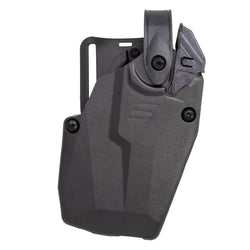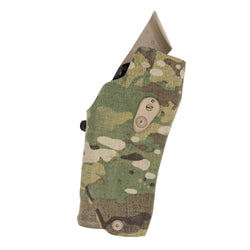Sometimes I come up with an idea for an article that I love, but it’s not until I’m putting words on a word processor that I realize it’s a hard article to write. That was the case with this one. I had no idea how much I’d type and backspace, trying to pin down what I think are the five most influential historic concealed carry handguns. I had to set up some rules to guide my choices, and I ended up narrowing them down to three.
First, nothing younger than a century. It’s got to be at least 100 years old, or first produced a century ago.
Second, there has to be a notable characteristic that has been influential on other concealed carry firearms to this day.
Finally, it has to be a commonly produced model, not a one-off or a limited run produced by a custom shop.

Guns like the Fitz Special or the ASP were influential, but they don’t make the list. Trust me, these rules were necessary, or I’d be typing and backspacing all day, and we’d get nowhere.
1. Queen Anne Pistol
The Queen Anne Pistol almost breaks the rules, which is a great way to kick off a list about historic concealed carry handguns. There was no major company producing Queen Anne Pistols; most were built by individual gunsmiths in small numbers. However, the design of a Queen Anne pistol was so popular that it was commonly produced.
The Queen Anne pistol is a breech-loading flintlock pistol which was often called a “turn-off” pistol. The barrel turns off (unscrews) from the frame, allowing it to be chamber-loaded instead of muzzle-loaded. These guns typically had rifled barrels and offered excellent accuracy.

They derived their name from the fact that they became popular during the rule of Queen Anne. What made these guns distinct was their small size. The turn-off barrel system was uniquely suited for making smaller, easy-to-conceal guns for the era.
These became known as “overcoat pistols” for how easily they could be hidden, or “muff pistols”—a muff being a small hand-warming device often carried by women. The Queen Anne Pistol is one of the earliest dedicated concealed carry firearms in history.
2. Colt Pocket Percussion Revolvers
The Colt Pocket Percussion Revolvers are known by many names. “Pocket Percussion” is an umbrella term that includes the Baby Paterson, the Baby Dragoon, the 1851 Navy Model, and the 1855 Sidehammer. While these are different guns, they all fall under the Pocket Percussion Revolver category.
These revolvers trimmed barrel length and caliber to make a pocket-friendly gun built on a familiar Colt frame with a familiar Colt action. Calibers varied from .28 to .36 caliber, depending on the gun. Five cylinders offered five shots from a pocket-sized gun.

Pockets were larger back then, and barrel lengths ranged from three to six inches. The Pocket Percussion series was extremely popular among the general population. These guns were carried nut just by the average joe, but also by also soldiers and police who wanted a lighter-weight, convenient firearm.
Colt’s percussion revolvers were one of the first easily concealable, mass-produced revolvers, as well as one of the first mass-produced repeating concealed carry guns. They set the stage for handguns that were smaller in both size and caliber.
3. S&W Safety Hammerless
Now let’s jump into the cartridge era with the S&W Safety Hammerless, also known as the New Departure or the Lemon Squeezer. It’s known by a few names, but it was one of the earliest cartridge-based concealed carry handguns.
The Safety Hammerless used an enclosed hammer and a double-action-only design. These five-shot guns were chambered in either .38 S&W or .32 S&W and most commonly came with 2-inch, 3-inch, or 3.5-inch barrels. Smith & Wesson also offered a number of six-inch barrel variants.

Unlike modern revolvers, these featured a top-break design. The barrel and cylinder rotated forward and downward, ejecting spent cases as the gun opened. They were surprisingly fast to reload.
These little guns became a popular choice and helped usher in the modern era of concealed carry revolvers. Concealed hammers, double-action-only designs, and short barrels remain popular features in concealed carry revolvers today.
4. FN M1905
Now let’s move into the automatic realm with one of the first pocket pistols that would still qualify as a pocket pistol today. The FN Model 1905, or M1905, is a John Browning design, and it’s extremely small, even by modern standards. These guns measured out to just 4.5 inches, with 2.1-inch barrels.
They chambered the .25 ACP cartridge and fed from a six-round detachable magazine. The sights were nearly nonexistent, making this very much a point-and-shoot type of firearm. The straight blowback design used a striker-fired system and was ultimately an extremely simple handgun.

The FN M1905 series was designed with personal protection in mind. Colt would later produce the M1908 Vest Pocket pistol, also based on Browning’s design. These tiny little fellas were easy to pocket and carry for everyone.
What brings the FN M1905 under the umbrella of historic concealed carry handguns is its truly micro-sized nature. Guns like the LCP, the P32, the S&W Bodyguard, and more all owe their existence to the FN M1905.
5. Savage Model 1907
The Savage Model 1907 was influential in a ton of ways when it comes to concealed carry. Savage built it specifically for personal defense and concealed carry. It’s a compact, semi-auto pistol produced primarily in .32 ACP and .380 ACP, with limited runs in .25 ACP and .45 ACP.
The Model 1907 held 10 rounds of .32 ACP or nine rounds of .380 ACP. It was often advertised with the slogan “Ten rounds quick!” Size-wise, it was 6.5 inches long overall with a 3.75-inch barrel.

In terms of influence, I often joke that the M1907 was the P365 of its time. It featured a 10-round double-stack magazine, and may have been the first handgun to use a double-stack. The gun was striker-fired and used a locked breech, which was a rarity for the era.
Savage even used influencer marketing, securing endorsements from gunfighters like Bat Masterson and Buffalo Bill Cody. Bat Masterson even wrote a self-defense guide that advertised the M1907. While it might not have been recognized for its innovation during the early 1900s, it has since become one of the most influential historic concealed carry firearms.
Know Your History
I know plenty of people will disagree with my list. Heck, I’ve found myself disagreeing with it a time or two! It’s tough to pick only five, but after several attempts to get this article written, I think I’ve finally settled on the five most influential historic concealed carry handguns.









